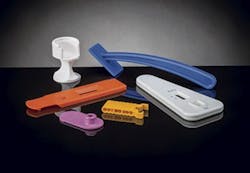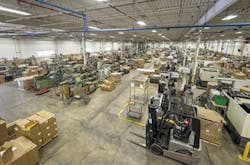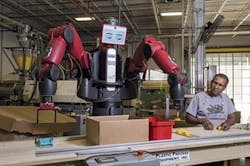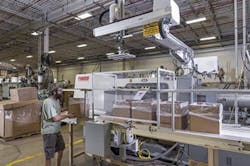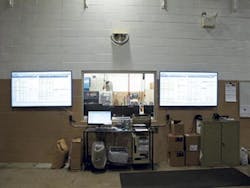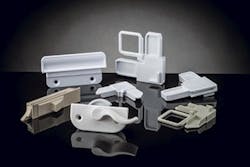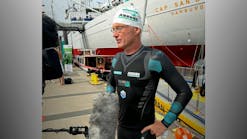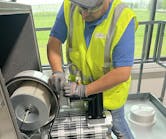Part-making know-how and tight internal standards are linchpins for the Rodon Group, an injection molder of high-volume, high-quality parts.
Established in 1956 by chemist Irving Glickman, the Hatfield, Pa., company differentiates itself by providing expertise throughout every stage of manufacturing, from part design and mold making to final production. Now in its third generation of ownership, it is one of the largest family-owned custom injection molding companies in the U.S. in terms of revenue and production volume.
Just the facts
COMPANY: The Rodon GroupHEADQUARTERS: Hatfield, Pa.OWNERS: Joel Glickman, chairman and CEO, Rodon Group LLC and Sterling Drive Ventures LP. Rodon is a subsidiary of Sterling Drive Ventures LP.FOUNDED: 1956EMPLOYEES: 120ANNUAL SALES: Undisclosed
"Our profile is high-volume, precision parts, and we will go into any industry where that profile takes us and it makes sense for us," Kevin McGrath, VP of sales
and marketing, told Plastics Machinery Magazine during a recent factory tour. The company serves more than 50 industries. Its portfolio includes consumer and construction products, window and door components, medical and pharmaceutical parts, and food and beverage packaging components.
RELIANCE ON NISSEI
Rodon has embraced automation and innovative technologies, including 3-D printing for prototyping, in a model that emphasizes consistency, quality and repeatability. It has adopted automated materials handling, top-of-the-line quality-control and production-scheduling technologies, and provided feedback as Rethink Robotics developed its collaborative robots, said Lowell Allen, senior VP of manufacturing.
The company purchased six new Nissei injection molding presses this year, including four 200-ton FNX models and two 400-ton models. In all, it operates 117 injection molding machines with clamping forces ranging from 46 tons to 400 tons. Most are Nissei FNX hybrid units, but Nissei Elject and ES models also are in operation. Each press is microprocessor-controlled and equipped with self-diagnostic capabilities.
Each aisle in the factory is organized around the clamping tonnages of the primary machines, with the same-size machines arranged in rows. Seventy material loaders from Automated Auxiliary Equipment supply resin to the machines, and five 200,000-pound-capacity silos containing the company's most commonly used resins are outside. Though machines are grouped together by size, each molding cell may have specific attributes — such as a hardened barrel, type of core-pull system or robot model — that make it the choice for a particular job.
As it buys new machines, the company decommissions older presses, some of which have been in operation for 20 years.
ROBOTS AT WORK
Along with its new Nissei machines, Rodon recently acquired six beam-mounted, three-axis robots from Star Automation, which has supplied virtually all the robots for its presses. Rodon incorporates either Star Automation's general-purpose SA series three-axis robot or its more versatile T-series robot, featuring servo wrists, onto its injection presses.
Just seven machine operators run the entire manufacturing facility per shift. "We have 75 full-servo robots that are vital to our manufacturing. We need people that know how to program and maintain them. We look for people that understand processing and molding. We typically execute 15 [product/mold] changeovers every 24 hours," McGrath said. Equipped with some type of automation/robot and a self-sufficient materials-handling system, each of Rodon's molding cells is set up to operate virtually unattended.
Rodon typically builds the end-of-arm-tooling (EOAT) for the robots used in its plant. When the company acquires new three-axis robots, the robotics department designs sub-arms that can be incorporated onto them. The sub-arm grabs the runner out of the mold as the main EOAT grabs the part. "We design and build the sub-arm in-house. It would be a $7,500 add-on if the robot maker included it as an option," Allen said.
In addition to the Star Automation robots, the company has used a Baxter collaborative robot from Rethink Robotics for the past five years. Featuring two arms, each with seven axes, the Baxter carries out part-handling or assembly operations as needed. Rodon shuttles the Baxter from press to press, and also uses it for demonstration purposes. "We use it for lighter packing or stacking tasks. It does the mundane jobs, so it doesn't take away a job a human would do, but does the monotonous jobs a human would not want to do," Allen said. Rodon said the Baxter robot packs parts so efficiently it has allowed Rodon to reduce its cardboard consumption by 20 percent to 40 percent.
AUTOMATED PART HANDLING
Part inspection and transfer also are automated. Rodon incorporates 26 visual inspection systems from Keyence. Parts are counted and boxed as they are made, with automated conveyors indexing a completed box to a post-mold position and installing an empty box ready for packing.
Automated part conveying systems come from a single source as well: Plastics Process Equipment. Employees use a special hand-held scanner from Intermec that not only generates the shipping label at the machine for parts that are packaged and ready to ship, but incorporates all process and production data relating to the packaged product in the bar code. That information is fed wirelessly to an enterprise resource planning (ERP) system from Made 2 Manage that updates inventories of raw materials, machine maintenance schedules and order-fulfillment.
COMPANY STANDARDS APPLY
For Rodon, turnkey production begins in the mold making area. "Our manufacturing profile is, if we cannot convert a mold to be run in an automated fashion, unattended, on our injection machine, we will not accept it. But we will always offer the customer the opportunity to retool to our specifications, to run it the way we run it," McGrath said.
As a result, the company generally runs projects that use molds it designs and builds; in some cases, it's also involved in reshoring, using tooling and molds that have returned to the U.S. from other countries. Rodon will build cold-runner, hot-runner, or three-plate molds ranging from one to 192 cavities. It not only builds molds to its own standards, typically accurate to 0.005 inch, but also guarantees each tool.
It recently added a special Mitutoyo unit that uses light and contrast to measure minute dimensions to its quality-control/metrology lab, and added several Matsui Seiki machining centers a few years ago to the mold shop. Over the last couple of years, it installed sinker electronic discharge machining (EDM) units from Mitsubishi.
Other recent equipment purchases include a 10-foot-by-10-foot-by-18 foot Kardex Remstar vertical storage system featuring trays that hold mold components, such as cavity blocks, for specific projects. It replaced an older carousel system and provides 10 times greater capacity, Allen said.
With more than 85 percent of business coming from custom molding jobs, Rodon prides itself on being able to add value to each of its designs. The company's expertise in mold building is evident in the proprietary items it's been able to produce. In 1992, Joel Glickman, son of the company's founder, invented the K'NEX line of interlocking rod-and-connector building construction toys. Twenty-five years later, Rodon continues to manufacture the parts, although the K'NEX line was sold two years ago to a private investment group.
As an example of the company's design prowess, McGrath pointed to Rodon's vinyl window-frame and latch components. In order to successfully enter this segment of the very competitive window and door market, Rodon looked at the challenges facing the production and performance of these parts, then developed unique solutions as part of its line of standard offerings.
"Instead of developing a me-too product, what we brought to the table was a problem-solving mentality," McGrath said.
BRINGING IT ALL TOGETHER
To organize its projects, Rodon uses a customized manufacturing execution system (MES). Two massive LED screens display the status and upcoming changes involving all of the plant's molding machines, arrayed by row. This production planning and scheduling system, which updates every 10 minutes, is one of the pillars of Rodon's operations.
At the beginning of every shift, machinery operators congregate around the screens to gather information on what is running on the lines they are managing.
Operators viewing the scheduling system see the press number, item number, product code, time to completion and number of cartons completed. A color code indicates the status of each press.
INFRASTRUCTURE IMPROVEMENTS
The company's focus on efficiency is evident throughout the facility, and even outside.
It has installed sensor-driven, energy-efficient lighting in the manufacturing space that turns on only when it detects movement. If the machine cell is fully automated, requiring no operator assistance, the lighting above the cell turns off. That saves Rodon about $5,000 a month, Allen said. The company also recently added a new roof that reflects heat during the summer, reducing cooling demand inside the plant.
Allen and McGrath, along with VP of tooling and design Chuck Rodgers, spend their workdays brainstorming how to streamline any and every aspect of the turnkey approach. "We do not farm out a lot of things, but there are a few specialty tasks, like wire EDM and heat treating, that we just do not do enough business in to justify a machinery purchase," Allen said.
Rodon's emphasis on automation has paid off. Since the 2008-2009 economic downturn, it has achieved double-digit sales and revenue growth. With machinery and equipment acquisitions, it's been able to make lasting investments that can guarantee 24/7 quality and repeatability.
Mikell Knights, senior staff reporter
